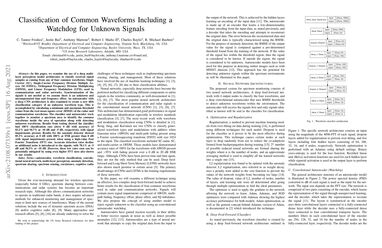Classification of Common Waveforms Including a Watchdog for Unknown Signals
In this paper, we examine the use of a deep multi-layer perceptron model architecture to classify received signal samples as coming from one of four common waveforms, Single Carrier (SC), Single-Carrier Frequency Division Multiple Access (SC-FDMA), Orthogonal Frequency Division Multiplexing (OFDM), and Linear Frequency Modulation (LFM), used in communication and radar networks. Synchronization of the signals is not needed as we assume there is an unknown and uncompensated time and frequency offset. An autoencoder with a deep CNN architecture is also examined to create a new fifth classification category of an unknown waveform type. This is accomplished by calculating a minimum and maximum threshold values from the root mean square error (RMSE) of the radar and communication waveforms. The classifier and autoencoder work together to monitor a spectrum area to identify the common waveforms inside the area of operation along with detecting unknown waveforms. Results from testing showed the classifier had 100\% classification rate above 0 dB with accuracy of 83.2\% and 94.7\% at -10 dB and -5 dB, respectively, with signal impairments present. Results for the anomaly detector showed 85.3\% accuracy at 0 dB with 100\% at SNR greater than 0 dB with signal impairments present when using a high-value Fast Fourier Transform (FFT) size. Accurate detection rates decline as additional noise is introduced to the signals, with 78.1\% at -5 dB and 56.5\% at -10 dB. However, these low rates seen can be potentially mitigated by using even higher FFT sizes also shown in our results.
PDF Abstract
